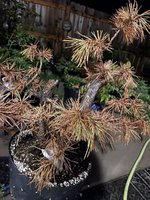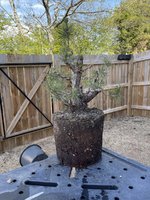I can't see the roots you're talking about, but I've successfully girdled some pine roots in the past. It essentially ground layers the fat root by cutting off supplies, and it takes about 3 years. No cuts need to be made until there are new roots forming above the girdle. And eventually you can saw the fat roots off.
Take a fat ziptie, and by fat I mean a wide one. And just zip it around the roots that you want to cut off. Then put the plant back into the pot and make sure that from the ziptie to the top of the soil, there's at least half an inch of soil left. An inch is better.
Then just treat it as a normal tree and let nature do the work.
Copper is out of the question because in soil it'll dissolve over time and release a whole bunch of copper. So that's why I prefer plastic. You pick the widest because you don't want it to grow over your girdle.





